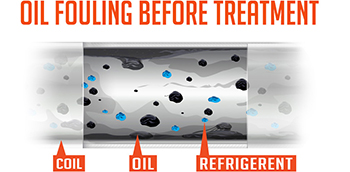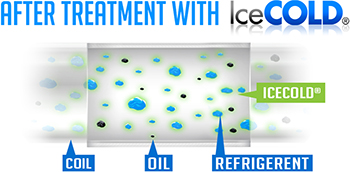How Does EcoCOOL® Work?
EcoCOOL® removes oil-fouling, thus improving coil heat transfer and delivering colder air faster. It also delivers 54% higher lubricity to compressor oil.*
What is oil fouling?
In virtually all air conditioning and refrigeration systems 1/2% to 8% of the compressor’s lubricating oil circulates with the refrigerant. This oil attaches to the inner walls of the refrigeration tubing and acts as an effective insulator to heat exchange. It is these oil deposits that ultimately block heat transfer and reduce your system efficiency.
Equipment suppliers may state that in a particular system, migrating oil concentration has been reduced to only one percent. The one percent being referred to is one percent of the total oil volume. If a compressor holds four quarts, or 128 ounces of oil, then at one percent, 1.28 ounces is flowing through the system at any given time. Since a capillary tube, oil pressure switch or expansion valve can be fouled with a few milligrams of oil, when one percent of any oil charge is flowing constantly through the system, the system will become oil-fouled.
* 1998 ASHRAE Handbook, Refrigeration, Chap. 6.7
Effects on Heat Transfer
Oil-fouling of the heat transfer surfaces of air conditioning and refrigeration systems will cause a loss of about 7% efficiency the first year, 5% the second year and 2% per year the following years.
According to ASHRAE, performance is degraded by as much as 30% due to the build-up of lubricants on internal surfaces.* Higher percentages have been observed in systems 20 years old or older.
* “A Survey of Refrigerant Heat Transfer and Pressure Drop Emphasizing Oil Effects and In-Tube Augmentation;” ASHRAE Winter Symposium of 1987; Schlager, Pate, and Bergles.
Managing The Problem
Some of the techniques used by manufacturers to control migrating oil include the use of mechanical devices, such as separators, skimmers, drums, heat sources, suction risers, traps and pumps. However, according to ASHRAE’s Handbook*, these high-tech designs are not efficient enough to remove all of the unwanted oil. Although the mechanical solutions may reduce the problems of restricted or plugged capillary tubes or sticky expansion valves, they do not resolve the boundary layer oil fouling over time.
*1998 ASHRAE Handbook, Refrigeration, Chap. 2.9
The Solution
The heat transfer efficiency loss due to oil-fouling is restored to near new equipment levels by using EcoCOOL®’s synthetic catalyst to break the Vander Waals (surface tension) forces between the oil globules and the walls of the refrigeration tubing. The absence of oil-fouling restores the loss of 20% to 30% heat transfer efficiency. An added benefit is that the capillary tubes, expansion valves and heat pump’s 4-way valves are also cleaned and will not oil-foul again.
The result is that EcoCOOL® delivers an average financial payback period of under twelve cooling months and a Return-On-Investment of up to 500%.


At this stage, the coils are occupied by the fouling oil at the same time as the refrigerant, slowing down the latter and preventing it from doing its job properly. In a fairly new system, the performance may be degraded by 30% due to this problem. However, it gets worse; because the oil will continue accumulating and the process performance can be degraded by up to 40%. To prevent this from happening, EcoCOOL should be added to the system. EcoCOOL is a synthetic catalyst made out of three components: a first catalyst that removes the oil fouling, a second catalyst that reacts with the refrigerant and causes it to evaporate at a lower temperature and a lubricity agent that helps the refrigerant’s circulation. EcoCOOL is not made from petroleum-based stock, but it contains molecules having a high percentage of carbon-hydrogen bonds. These are ‘intelligent’ molecules that work for a specific purpose, in this case to enhance the refrigerant’s circulation and, thus, improve the system’s performance and reduce its energy consumption.












